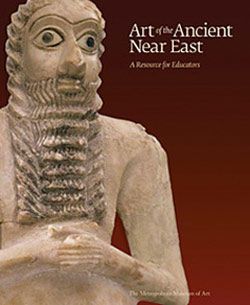Panel with a tree pattern
Not on view
This piece of ivory furniture was found in a storage room in Fort Shalmaneser, a royal building at Nimrud that was used to store booty and tribute collected by the Assyrians while on military campaign. It was probably part of a bed or couch, judging from the long strips of ivory inlay associated with it, which are also in the Metropolitan Museum’s collection (59.107.2a, b). Nineteen other similar furniture pieces, probably chair backs, were stacked in orderly rows in the same storage room. They are rare examples of ancient ivory furniture still in its original form; usually, the wooden frames holding the ivory pieces together have disintegrated by the time they are excavated, but since these chairs and couches were buried after the sack of the Assyrian palaces in 612 B.C., their arrangement was preserved. Set in a modern wood frame, this piece combines plain flat strips of ivory with three vertical rows of plant forms, each bordered on both sides with rows of circles with ivory stars inside. Two additional rows of stars in circles mark the edges, and the top is fitted with a plain curved molding in ivory that originally alternated with another material, perhaps wood or metal, now missing and restored in wood. This piece is the only furniture element from the storeroom decorated with non-figural imagery.
Built by the Assyrian king Ashurnasirpal II, the palaces and storerooms of Nimrud housed thousands of pieces of carved ivory. Most of the ivories served as furniture inlays or small precious objects such as boxes. While some of them were carved in the same style as the large Assyrian reliefs lining the walls of the Northwest Palace, the majority of the ivories display images and styles related to the arts of North Syria and the Phoenician city-states. Phoenician style ivories are distinguished by their use of imagery related to Egyptian art, such as sphinxes and figures wearing pharaonic crowns, and the use of elaborate carving techniques such as openwork and colored glass inlay. North Syrian style ivories tend to depict stockier figures in more dynamic compositions, carved as solid plaques with fewer added decorative elements. However, some pieces do not fit easily into any of these three styles. Most of the ivories were probably collected by the Assyrian kings as tribute from vassal states, and as booty from conquered enemies, while some may have been manufactured in workshops at Nimrud. The ivory tusks that provided the raw material for these objects were almost certainly from African elephants, imported from lands south of Egypt, although elephants did inhabit several river valleys in Syria until they were hunted to extinction by the end of the eighth century B.C.
Due to rights restrictions, this image cannot be enlarged, viewed at full screen, or downloaded.


